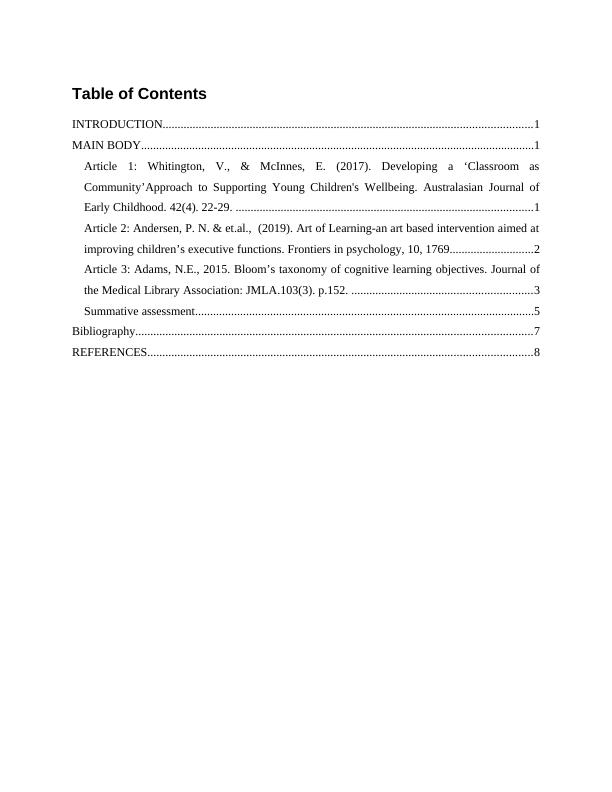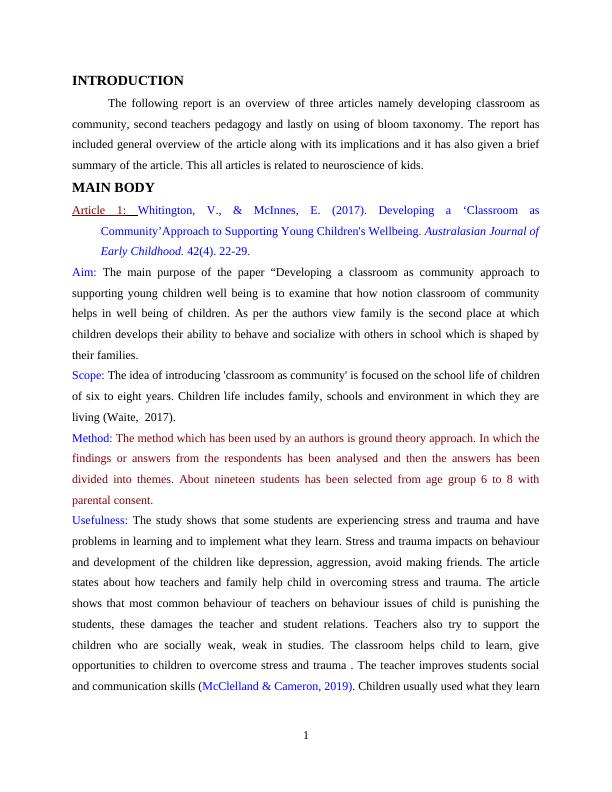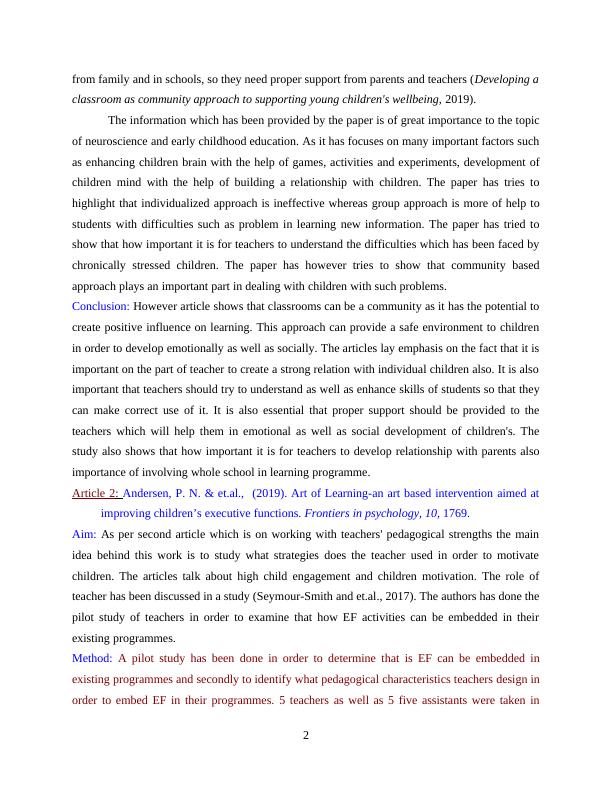Annotated Bibliography Report
14 Pages3036 Words128 Views
Added on 2021-02-21
Annotated Bibliography Report
Added on 2021-02-21
ShareRelated Documents
Title Annotated Bibliography

Table of ContentsINTRODUCTION...........................................................................................................................1MAIN BODY...................................................................................................................................1Article 1: Whitington, V., & McInnes, E. (2017). Developing a ‘Classroom asCommunity’Approach to Supporting Young Children's Wellbeing. Australasian Journal ofEarly Childhood. 42(4). 22-29. ...................................................................................................1Article 2: Andersen, P. N. & et.al., (2019). Art of Learning-an art based intervention aimed atimproving children’s executive functions. Frontiers in psychology, 10, 1769............................2Article 3: Adams, N.E., 2015. Bloom’s taxonomy of cognitive learning objectives.Journal ofthe Medical Library Association: JMLA.103(3). p.152. ............................................................3Summative assessment.................................................................................................................5Bibliography....................................................................................................................................7REFERENCES................................................................................................................................8

INTRODUCTIONThe following report is an overview of three articles namely developing classroom ascommunity, second teachers pedagogy and lastly on using of bloom taxonomy. The report hasincluded general overview of the article along with its implications and it has also given a briefsummary of the article. This all articles is related to neuroscience of kids. MAIN BODYArticle 1:Whitington, V., & McInnes, E. (2017). Developing a ‘Classroom asCommunity’Approach to Supporting Young Children's Wellbeing. Australasian Journal ofEarly Childhood.42(4). 22-29.Aim: The main purpose of the paper “Developing a classroom as community approach tosupporting young children well being is to examine that how notion classroom of communityhelps in well being of children. As per the authors view family is the second place at whichchildren develops their ability to behave and socialize with others in school which is shaped bytheir families.Scope: The idea of introducing 'classroom as community' is focused on the school life of childrenof six to eight years. Children life includes family, schools and environment in which they areliving (Waite, 2017). Method: The method which has been used by an authors is ground theory approach. In which thefindings or answers from the respondents has been analysed and then the answers has beendivided into themes. About nineteen students has been selected from age group 6 to 8 withparental consent. Usefulness: The study shows that some students are experiencing stress and trauma and haveproblems in learning and to implement what they learn. Stress and trauma impacts on behaviourand development of the children like depression, aggression, avoid making friends. The articlestates about how teachers and family help child in overcoming stress and trauma. The articleshows that most common behaviour of teachers on behaviour issues of child is punishing thestudents, these damages the teacher and student relations. Teachers also try to support thechildren who are socially weak, weak in studies. The classroom helps child to learn, giveopportunities to children to overcome stress and trauma . The teacher improves students socialand communication skills (McClelland & Cameron, 2019). Children usually used what they learn1

from family and in schools, so they need proper support from parents and teachers (Developing aclassroom as community approach to supporting young children's wellbeing, 2019).The information which has been provided by the paper is of great importance to the topicof neuroscience and early childhood education. As it has focuses on many important factors suchas enhancing children brain with the help of games, activities and experiments, development ofchildren mind with the help of building a relationship with children. The paper has tries tohighlight that individualized approach is ineffective whereas group approach is more of help tostudents with difficulties such as problem in learning new information. The paper has tried toshow that how important it is for teachers to understand the difficulties which has been faced bychronically stressed children. The paper has however tries to show that community basedapproach plays an important part in dealing with children with such problems. Conclusion: However article shows that classrooms can be a community as it has the potential tocreate positive influence on learning. This approach can provide a safe environment to childrenin order to develop emotionally as well as socially. The articles lay emphasis on the fact that it isimportant on the part of teacher to create a strong relation with individual children also. It is alsoimportant that teachers should try to understand as well as enhance skills of students so that theycan make correct use of it. It is also essential that proper support should be provided to theteachers which will help them in emotional as well as social development of children's. Thestudy also shows that how important it is for teachers to develop relationship with parents alsoimportance of involving whole school in learning programme. Article 2: Andersen, P. N. & et.al., (2019). Art of Learning-an art based intervention aimed atimproving children’s executive functions. Frontiers in psychology, 10, 1769.Aim: As per second article which is on working with teachers' pedagogical strengths the mainidea behind this work is to study what strategies does the teacher used in order to motivatechildren. The articles talk about high child engagement and children motivation. The role ofteacher has been discussed in a study (Seymour-Smith and et.al., 2017). The authors has done thepilot study of teachers in order to examine that how EF activities can be embedded in theirexisting programmes. Method: A pilot study has been done in order to determine that is EF can be embedded inexisting programmes and secondly to identify what pedagogical characteristics teachers design inorder to embed EF in their programmes.5 teachers as well as 5 five assistants were taken in2

End of preview
Want to access all the pages? Upload your documents or become a member.
Related Documents
The Application of Blooms Questioninglg...
|4
|854
|307
Child Developmentlg...
|4
|1053
|54
Key Elements of Framework's Policy on Parent and Community Partnershipslg...
|6
|977
|151
Childhood Studies: Behavioural Engagement in the Transition to Schoollg...
|10
|2858
|295
Key elements of the Framework’s policy on parent and community partnershipslg...
|5
|888
|192
Wellness and Wellbeing of Educators in Early Childhood Educationlg...
|12
|1118
|77
